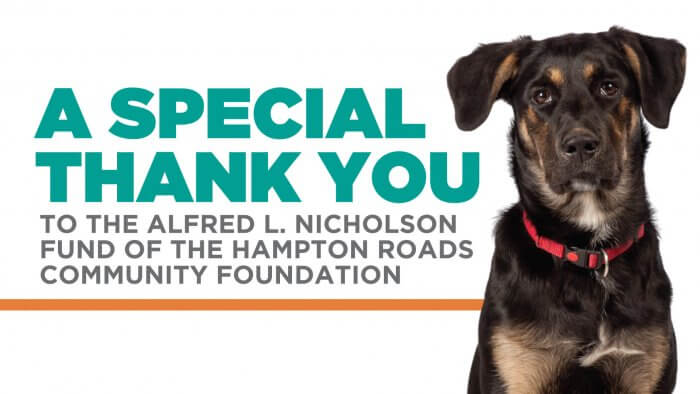
The Virginia Beach SPCA Receives $115K In Grant Funding from the Hampton Roads Community Foundation
We are very excited to announce that the Virginia Beach SPCA has received a substantial grant of $115,000 from the Alfred L. Nicholson Fund of the Hampton Roads Community Foundation. The majority of the grant funding will cover capital improvements with additional funding to aid in COVID-19 relief. The VBSPCA has been receiving grant funding from the HRCF since 2010, and their continued support has had a significant impact on our organization, ultimately improving our facility and our ability to provide compassionate care to both shelter and public animal populations. The Hampton Roads Community Foundation is southeastern Virginia’s largest grant and scholarship provider. Since its founding in 1950, the regional community foundation has provided more than $300 million in grants and scholarships to improve life in our local communities.
The funds awarded to the Virginia Beach SPCA in 2021 will be used to make necessary improvements throughout the shelter and clinic, including a major upgrade to our server and clinic software as well as new lighting in our parking lot to improve safety on our property. Most importantly, the funds will help decrease the stress levels for our animals through the installation of sound absorbent acoustical tiles in our kennel and lobby and the addition of a divider wall in our kennel. Improvements will also be made to our doors to minimize the sound that travels from the kennel to the cattery, decreasing the stress levels in our feline residents. We are part way through the completion of these projects and look forward to full completion later this summer.
Alfred L. Nicholson served on the boards of area animal shelters and owned the Canine Country Club in Virginia Beach. Nicholson, who was nicknamed Captain Nick, died in 1997 at age 93. His bequest created a field-of-interest fund at the Hampton Roads Community Foundation that will forever help animals in need. “The Alfred L. Nicholson Fund provides the VBSPCA the opportunity to care for animals until they find their forever homes,” said Linda Rice, Vice President for Grantmaking. “The community foundation applauds area shelters that show compassion for the welfare of the region’s vulnerable animals.”
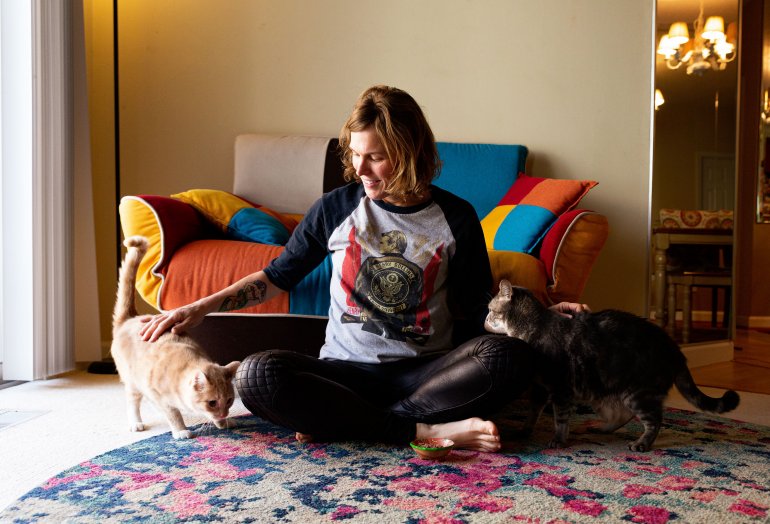
Happy Tails – Apollo & Neptune
Every single animal that comes through our shelter has a story. Some are complex, many are sad, but all of them get better the minute they arrive at the Virginia Beach SPCA. Apollo and Neptune came to our shelter in November 2019 when their owner could no longer take care of them. The cats were very attached to each other and needed to go to a new home together. About a month later, Sylvie and her three teenagers met the pair and fell in love. We recently caught up with Sylvie to check in on Apollo and Neptune.
How did Apollo and Neptune come into your life?
 My teenage daughter was battling depression pretty hard last winter. One morning we decided we were going to go get a cat. We looked around the VBSPCA at all the gorgeous cats, but we loved the way Apollo and Neptune were bonded to each other. We also liked that they looked so different from each other.
My teenage daughter was battling depression pretty hard last winter. One morning we decided we were going to go get a cat. We looked around the VBSPCA at all the gorgeous cats, but we loved the way Apollo and Neptune were bonded to each other. We also liked that they looked so different from each other.
How are your cats doing in the home?
It’s their home now; they just let us live here. I have invested in two air purifiers and a Roomba, though.
What do the cats like to do at home?
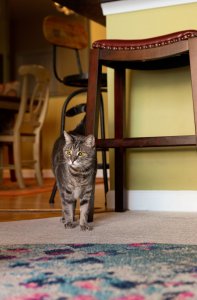 They chase each other down the hall at quite a gallop. Whenever anyone witnesses their charging down the hall, they’re very surprised at how loud and fast they are. That’s my cue to say: “Ladies and gentlemen, the miniature horses of Catalina Island!” They really do sound like little horses.
They chase each other down the hall at quite a gallop. Whenever anyone witnesses their charging down the hall, they’re very surprised at how loud and fast they are. That’s my cue to say: “Ladies and gentlemen, the miniature horses of Catalina Island!” They really do sound like little horses.
How have they enriched your life?
I cannot believe I used to live alone. My three teenagers live with me part-time, so they’re here some days, but I can’t imagine ever coming home to an empty apartment, especially during this past year. The term “emotional support animal” shouldn’t just apply to a particular animal; they’re all emotional support animals as far as I’m concerned (and almost all of us could benefit).
Why do you think people should consider adopting a pet from a shelter?
Cats are easy because they like to do their own thing most of the time, but I do spend a lot of my time during the day taking pictures of my cats; they’re always doing something cute or funny. I like that I was able to choose two cats that get along so well already – and also knew how to use the litter box. There are so many gorgeous pets who need homes. It’s a great feeling to be able to provide one.

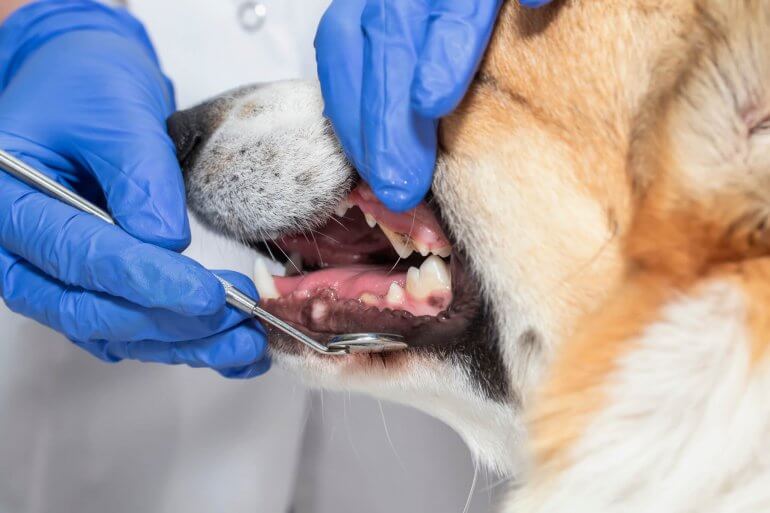
Pet Dental Health | Why Exams are So Important
Just like humans, dental health is extremely important for dogs and cats. Yet dental disease is all too common – it is the number one illness affecting pets. Maintaining healthy teeth and gums can prevent Periodontal disease, which is linked to other health problems including kidney, liver, and heart disease. To make sure you’re taking the best care of your feline or canine companion, here are some things you can do to ensure that dental health remains a top priority.
Yearly Exam
Dogs and cats should have their teeth and gums examined by a veterinarian once a year. Veterinarians will check your pet for broken teeth or roots, periodontal disease, abscesses or infected teeth, and other dental issues.
Watch for Signs of Trouble
There are several warning signs of dental problems. If you notice any of the following, you should visit your veterinarian:
- Bad Breath
- Broken or Loose Teeth
- Discolored Teeth
- Tartar Buildup
- Pain, Swelling, or Bleeding in/around Mouth
- Reduced Interest in Food or Refusal to Eat
Dental Surgery
If your veterinarian notices any issues with your pet’s teeth, they will recommend dental surgery. Dental surgeries include a thorough cleaning as well as any other necessary procedure such as extractions and/or filings. The veterinarian will take x-rays before the surgery begins to get a better picture of your pet’s dental health. Your pet will be placed under anesthesia during the dental procedure to minimize stress and pain. Most pets can go home the same day of their surgery and will just be a little groggy afterwards.
The American Veterinary Medical Association also recommends brushing your pet’s teeth at least a few times per week at home, but some dogs or cats may not be tolerant of this practice even with training. There are various dental products, treats, and diets you can try, however, you should always consult your veterinarian about what is appropriate for your pet.
Prevention and treatment of dental disease are key. In fact, pets that receive good dental care live 20% longer! Talk with your veterinarian about what you can do to improve your pet’s dental health.

Todd Eichman | In Service to the VBSPCA for 25+ Years
Todd Eichman has been serving on the Virginia Beach SPCA Board of Directors for over 25 years. “I have had an affinity for animals since I was very young,” he says. “We always had dogs and cats in the house, and the ability to help speak for those who can’t drew me to help the VBSPCA.”
 As an experienced CPA and CFP, Eichman shares his financial expertise with the VBSPCA. He is currently a partner with Sterling Benefits, LLC in Virginia Beach, where he assists small businesses and individuals with retirement planning. Prior to that, Eichman spent 11 tax seasons at a large accounting firm. He lives in Suffolk with his wife, two daughters, two cats, and a cockatiel.
As an experienced CPA and CFP, Eichman shares his financial expertise with the VBSPCA. He is currently a partner with Sterling Benefits, LLC in Virginia Beach, where he assists small businesses and individuals with retirement planning. Prior to that, Eichman spent 11 tax seasons at a large accounting firm. He lives in Suffolk with his wife, two daughters, two cats, and a cockatiel.
Eichman is a strong advocate for the VBSPCA’s spaying and neutering services, which he believes have had a major impact on the number of unwanted animals in our community. “We have spayed and neutered thousands upon thousands of animals during my tenure on the board and I can’t imagine where we would be as a community without [those services],” he says.
Eichman not only contributes to the VBSPCA mission by sharing his financial guidance, but through his hopeful outlook on animal welfare as well. His words of advice to the public? “Everyone should visit the shelter – it is not a sad or depressing place – it is a place of hope! Find somewhere in the organization where you can donate money or time and see what happens!” Todd, we so appreciate your many years of dedicated service to our animals!
If you are interested in serving on the Virginia Beach SPCA Board of Directors, please email Derby.Brackett@vbspca.com for more information.
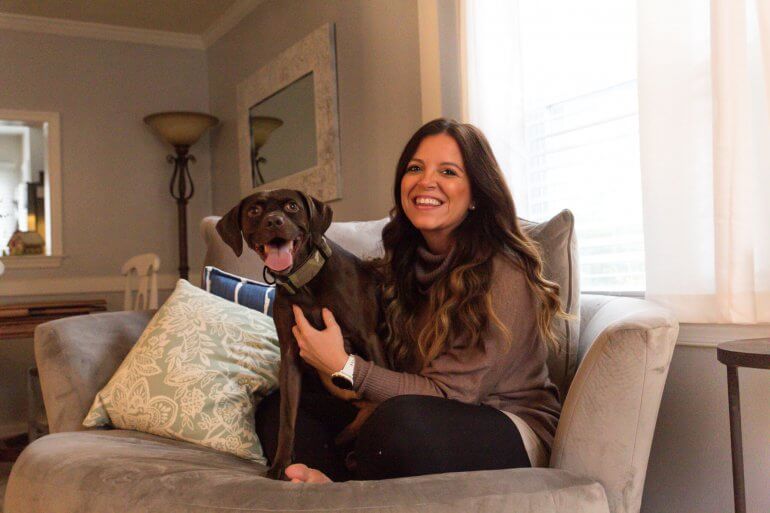
Happy Tails | Leroy
Every single animal that comes through our shelter has a story. Some are complex, many are sad, but all of them get better the minute they arrive at the Virginia Beach SPCA. Leroy came to the shelter when his family was moving and couldn’t take him with them. For Tasha, it was love at first sight – she saw him on our website and was immediately smitten. Once Tasha and Leroy met in July 2017, there was no turning back.
How did you find Leroy and/or how did you know Leroy was the one for you?
 About two years prior, my dog passed away. I was starting to get the itch for a new bud and I started checking the VBSPCA webpage every few weeks. I figured Leroy would be scooped up immediately, but when I called they told me he had a cough and was not taking visitors. I waited the seven days and visited him the day he was “released”. The first thing I noticed was his energy. I went back the next day and took him outside with the tennis ball and never looked back.
About two years prior, my dog passed away. I was starting to get the itch for a new bud and I started checking the VBSPCA webpage every few weeks. I figured Leroy would be scooped up immediately, but when I called they told me he had a cough and was not taking visitors. I waited the seven days and visited him the day he was “released”. The first thing I noticed was his energy. I went back the next day and took him outside with the tennis ball and never looked back.
How is Leroy doing in the home?
Leroy has been the PERFECT dog since day one. Crate trained, well behaved, fun, snuggly. He’s the epitome of a little best bud.
What sort of activities do you and Leroy do together?
Leroy has a TON of energy. We run and walk A LOT. His favorites include: car rides, trail runs at First Landing, chasing the ball for hours, swimming, and snuggling. Whenever we go on an adventure, Leroy comes too!
Does Leroy have any funny quirks?
Leroy’s best quirk is his need to snuggle CLOSELY and UNDER the covers. If there’s a blanket on the couch, he will get himself positioned just right under it. When we let him on the bed, he will inch his way under all of the bedding. He must be as close as possible at all times.
Why do you think people should consider adopting a pet from a shelter?
There are SO many amazing dogs just waiting to be taken home and loved. Our shelter dog has changed our life just as much as we changed his. Adopt before you shop!
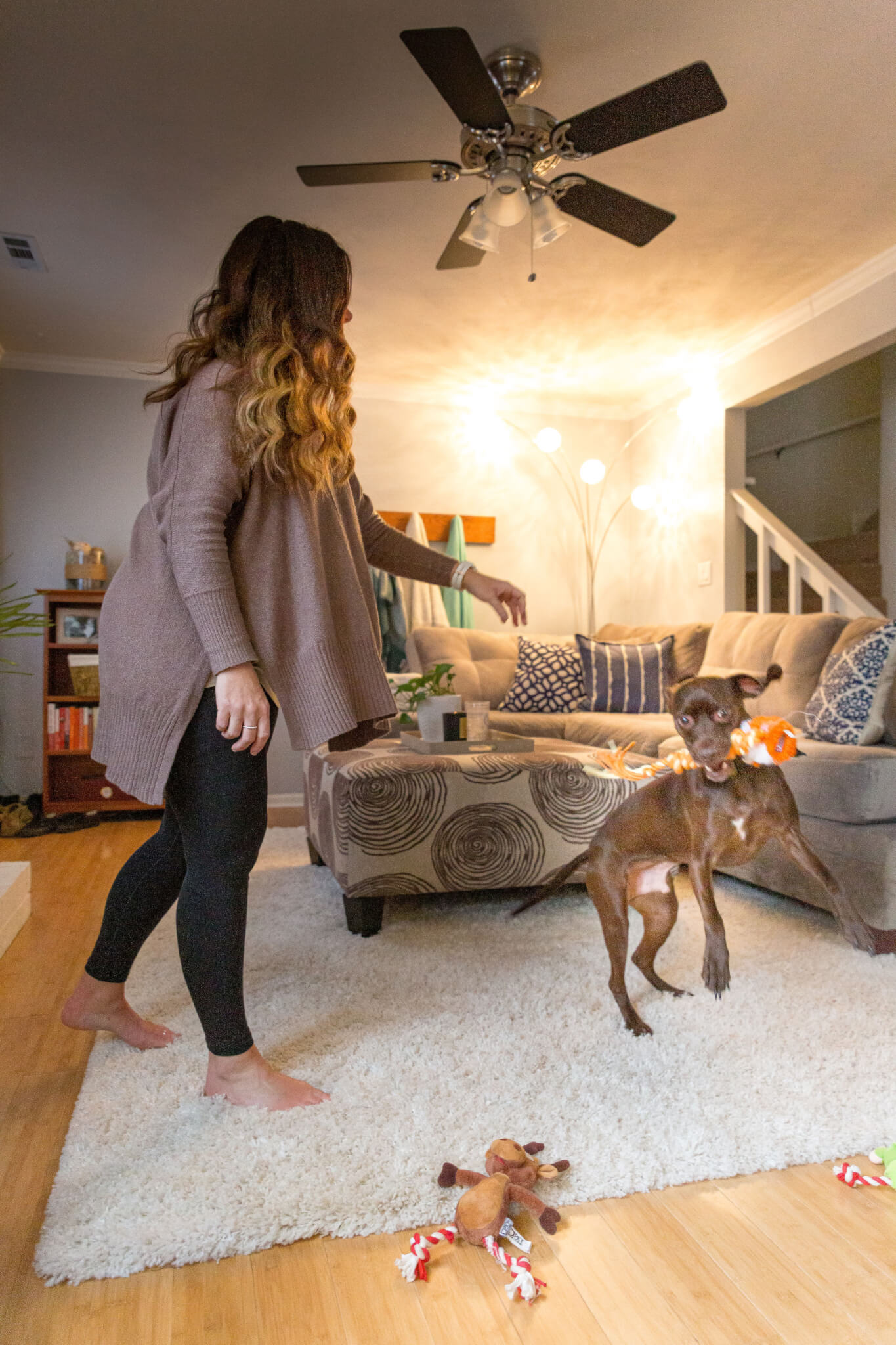
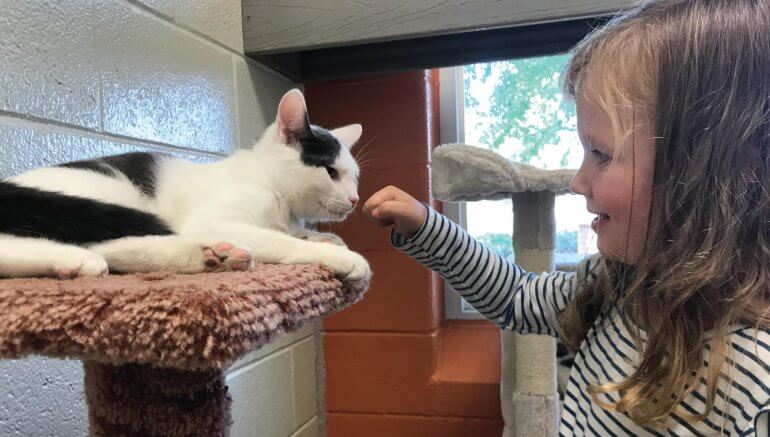
Building Trust – Keeping Kids and Pets Safe
The home should be a safe environment for everyone, including children and pets. Whether you’re welcoming a new baby, adopting a new pet, or having young visitors in your home, it can take some time for everyone to adjust. By being proactive you can create a harmonious environment for humans and animals alike.
For the Kids:
- Monitor children and pets who don’t know one another. Introductions should always be done under close adult supervision. Make sure your child knows to ask an adult for permission before approaching or touching any animal they don’t know.
- Teach kindness and respect. Simple things like showing children how and where to pet the animal, letting them know that animals have feelings, and asking them to not to touch your pet’s food or toys can go a long way.
- Talk about how animals communicate. Let your child know that if your cat or dog is growling, hissing, cowering, or trying to get away from them, they need to leave the animal alone.
For the Pets:
- Create safe zones for your pet. Make sure your pet has a place to eat and an area to sleep and relax where children know he should not be bothered.
- Allow your pet to decide whether to interact with children. Some animals are leery of kids since they tend to move fast and can be noisy. If their go-to response is avoidance, respect your pet’s wishes and try to create trust between the pet and the child over time.
- Intervene when play gets out of control. It doesn’t matter if it’s a child or a pet who gets a little too rambunctious – quickly calm the situation down so no one gets hurt.
Interactions with pets and other animals can be very beneficial to children. Caring for a pet can teach children empathy, kindness, and responsibility. Pets also provide companionship and even boost confidence and lower stress levels! By setting your children and your pets up for success, everyone will be able to enjoy their time together safely.
To learn about our humane education programs visit vbspca.com/education.
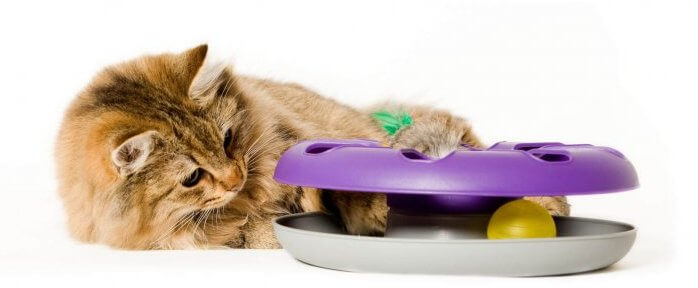
Selecting Safe Pet Toys For Your Furry Friends
Most animal lovers enjoy spoiling our pets with love and toys. If you’re shopping for your furry friend, you are not alone – pet products continue to grow in popularity in the US and around the world. The good news is there are plenty of options when it comes to entertaining your pet. But while it can be fun to pick the cutest or silliest toy you can find, it is important to consider your pet’s safety when you are buying toys.
Size Matters
When you are buying toys for your pet, be sure to think about the size of your animal. Small toys can be a choking hazard for larger pets, and large toys may be hard for a smaller pet to carry around.
Look Closely
Even appropriately sized pet toys can be hazardous because of the way they are made. Common hazards include “eyes” on soft toys, strings, ribbons, or any part of a toy that can easily be chewed off and ingested.
When in Doubt, Test it Out
Whenever possible, it is a good idea to supervise your pet with new toys. You’ll quickly realize whether your dog has a tendency to tear the stuffing out of soft toys and eat it or your cat often gets string or feathers stuck in his mouth. You may find that you have two categories of toys in your home: ones that can be left for your pet to play with at any time, and others that are put away and only used when under your close supervision to prevent any safety issues.
Choose Your Chews Wisely
Dogs naturally like to chew, but edible chews can be extremely dangerous. As your pup chews off pieces of the treat, it can get lodged in his throat or digestive tract. Carefully choose the size and shape of any edible chew, and only let your pet have it when you can watch them.
If you’re looking for something you can leave with your pets when you are not home, treat-dispensing toys can be a great option. You may also want to consider chew toys made of hard rubber, which are much less likely to become a choking hazard.
By thinking through your pet’s play behaviors and closely looking at the toys you buy, you’ll be able to enjoy playtime and worry less about unexpected trips to the veterinarian.
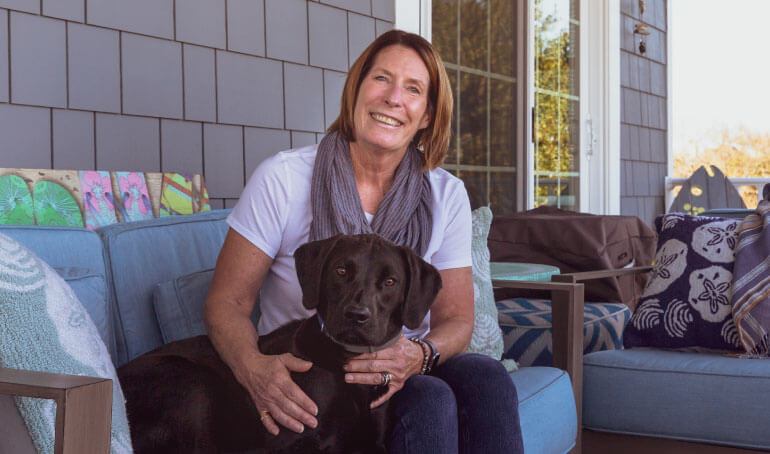
Happy Tails | Rambler
In the spirit of Thanksgiving, our November Happy Tails highlights an adopter for whom all of us at the Virginia Beach SPCA feel a tremendous amount of gratitude – our very own Derby Brackett. Derby has been serving the VBSPCA since September 2017. She first joined the organization as a board member, then stepped in as Interim CEO 6 months later, and she took on the official CEO position in March 2019. However, it wasn’t until January 2020 that Derby adopted VBSPCA pup Rambler, and together they represent one of over 2,700 happily ever afters from this past year.
 Rambler’s Story
Rambler’s Story
Rambler and his 8 littermates arrived at the VBSPCA on December 26, 2019. They were barely 6 weeks old, motherless, and all of them in need of medical care for serious parasitic infections. After the puppies were treated in our clinic, our shelter team placed the puppies in foster homes where they would be able to rest and recover until they were ready for adoption. Placement for all 8 pups was secured in less than 24 hours, and our Director of Philanthropy, Emily Peck, had signed up to take Rambler and one of his brothers home on foster. However, Emily was out of town for the holiday weekend, so Derby stepped in to foster Rambler and his brother until she returned.
This was Derby’s first foster experience, and her weekend with the puppies was both challenging and rewarding – but mostly rewarding. Resident 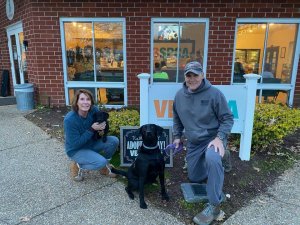 pet Rainey Storm warmed to the pups’ presence in the home, and her nerves shifted to curiosity. Everyone was friendly in no time. A few days of fostering turned into a few weeks of fostering, and when it was finally time for Derby to bring the puppies back to the shelter, Rambler was already home.
pet Rainey Storm warmed to the pups’ presence in the home, and her nerves shifted to curiosity. Everyone was friendly in no time. A few days of fostering turned into a few weeks of fostering, and when it was finally time for Derby to bring the puppies back to the shelter, Rambler was already home.
His First Year with Derby
At the end of this year, Rambler will celebrate his one year anniversary with Derby and her husband Doug, and what a year it has been. Despite the chaos us humans were experiencing throughout 2020, Rambler experienced a year of chasing waves at the beach, digging holes in the backyard, walking in the park, and playing with his big sister, Rainey Storm. He spent much of the year taking up too much space in the bed, being startled by the vacuum, and harmonizing with the sirens. He made a few appearances in Zoom meetings and ruined a few shoes, but overall he brought immense joy and unlimited entertainment to his humans. For Rambler and all of our animal friends, 2020 was a year of being loved by their human companions, and that love is central to everything we do at the VBSPCA.
In Thanks
We offer our thanks to Derby for providing Rambler with a loving, forever home, and we thank her for the compassionate leadership she uses to guide the entire VBSPCA team every single day. Derby leads with compassion and dedication – and, as 2020 has taught us – when nothing goes as planned, compassion and dedication matter most.
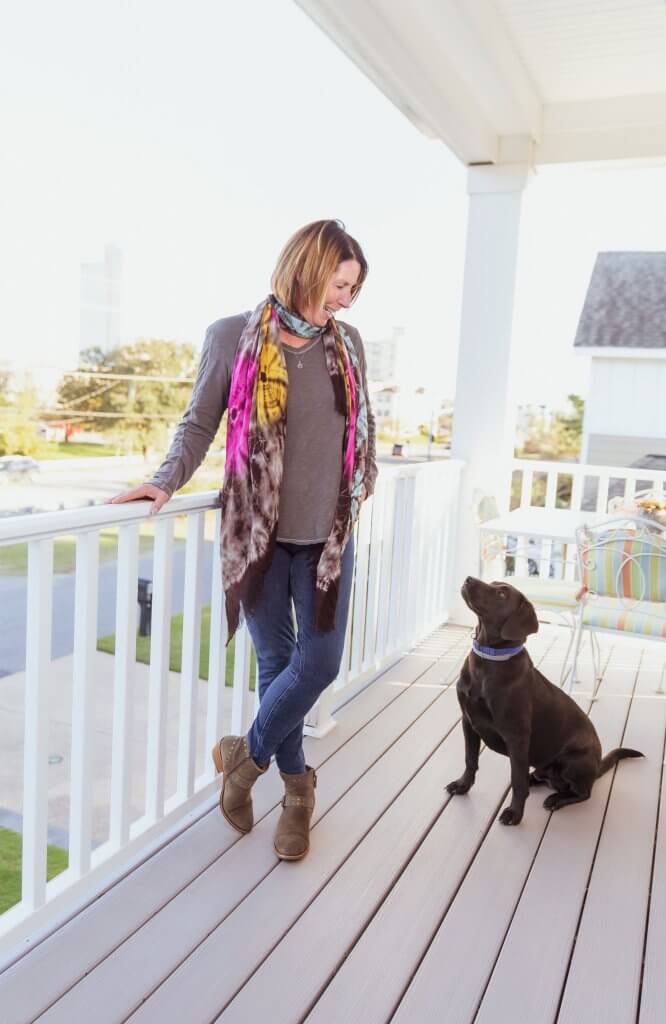

Brad Kuether | In Service to the Animals Since 2013
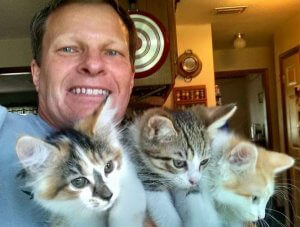 Brad Kuether has been serving on the Virginia Beach SPCA Board of Directors since 2013. His initial involvement with the organization began through our volunteer program, through which he donated his time and energy to both our kennel and foster programs. Eventually he was approached by leadership to join the board as a representative of our shelter volunteers, and he has been in board service ever since.
Brad Kuether has been serving on the Virginia Beach SPCA Board of Directors since 2013. His initial involvement with the organization began through our volunteer program, through which he donated his time and energy to both our kennel and foster programs. Eventually he was approached by leadership to join the board as a representative of our shelter volunteers, and he has been in board service ever since.
Brad’s professional life has been a mixture of military service in the US Navy and working in private industry. He spent 24 years as an Officer in the Navy, starting out flying A-6E Intruder aircraft, later serving as an Instructor at the Naval Aviation Schools Command, and completing tours at a Tactical Air Control Squadron, CINCLANTFLT, MIDLANT, and finally at Second Fleet. Brad also worked as the Training Development Manager for Coastal Training Technologies and as a contractor on several training development projects including developing the first computer based SCUBA knowledge training. For the past 13 years, he has worked for General Dynamics Information Technology as a Project Manager. He has managed projects for various customers including the US Navy, NATO, FAA, and currently to develop F/A-18 Pilot training for the Finnish Air Force. Brad’s board service has allowed him to remain involved with animal care, and he continues to foster kittens on a regular basis. He has served as co-chair on our Mutt Masquerade planning committee and has been a committed running participant in the event for years. Brad encourages members of our community to join the VBSPCA mission through volunteerism, event attendance, and donations.
Brad Kuether’s voice on the board is important as he represents the many members of our community who share in his experiences, interests, and passion for animal welfare. Thank you, Brad, for your dedication to the Virginia Beach SPCA.
If you are interested in serving on the VBSPCA board, please email Derby.Brackett@vbspca.com for more information.

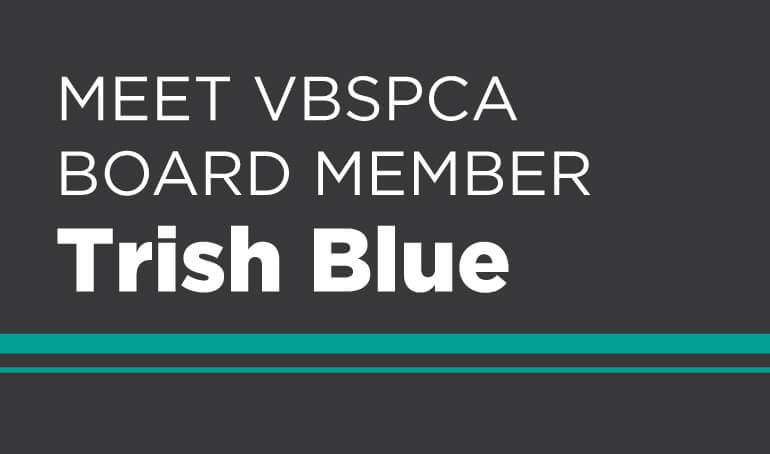
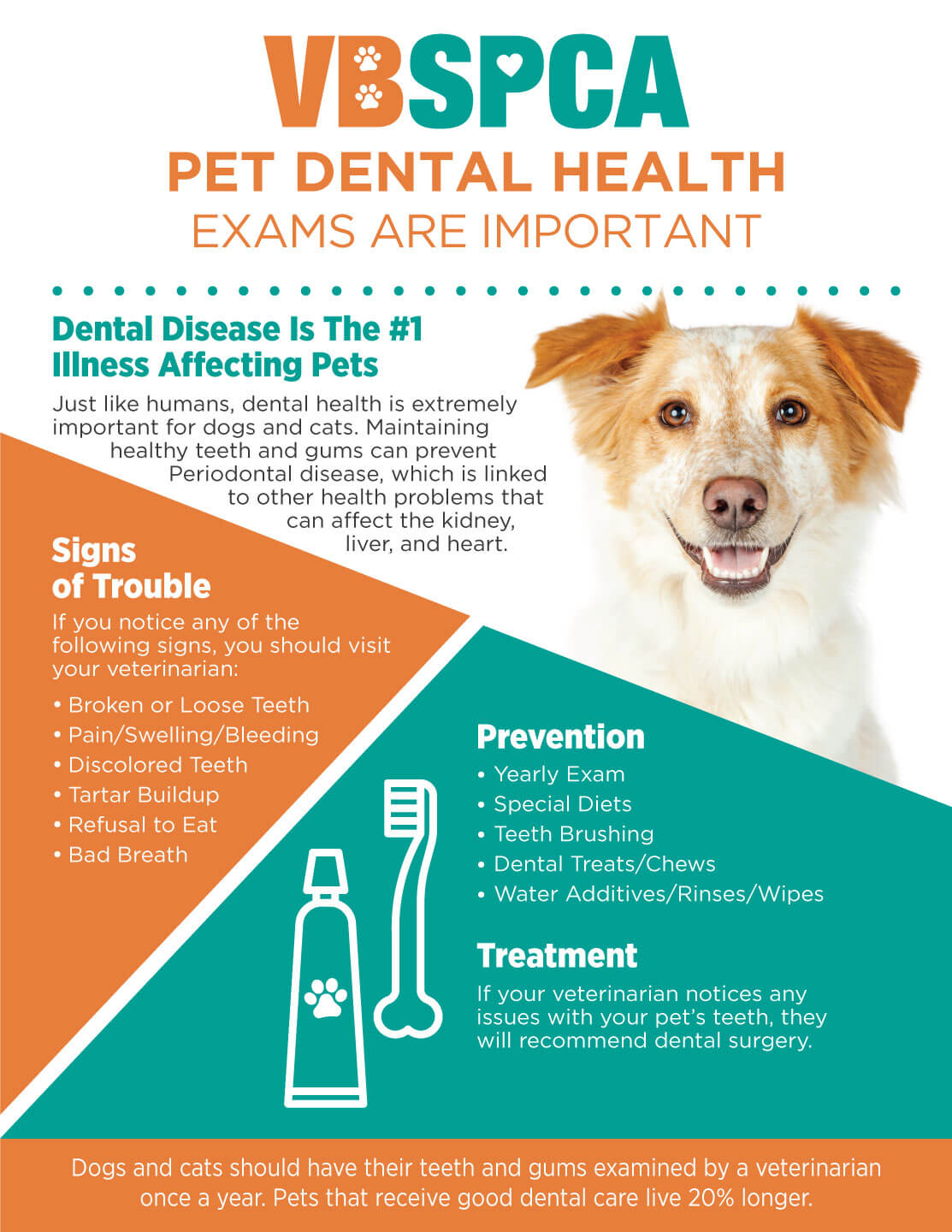
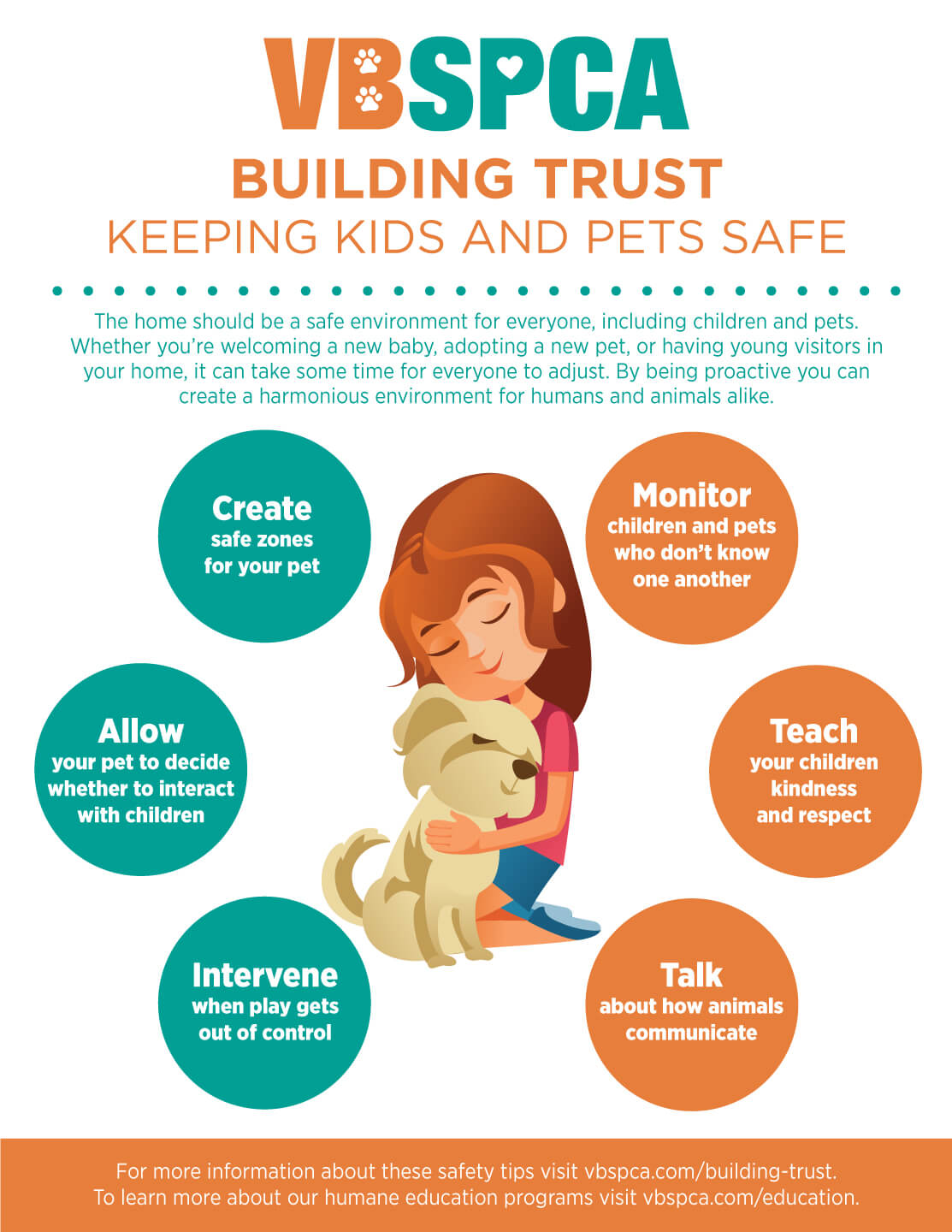
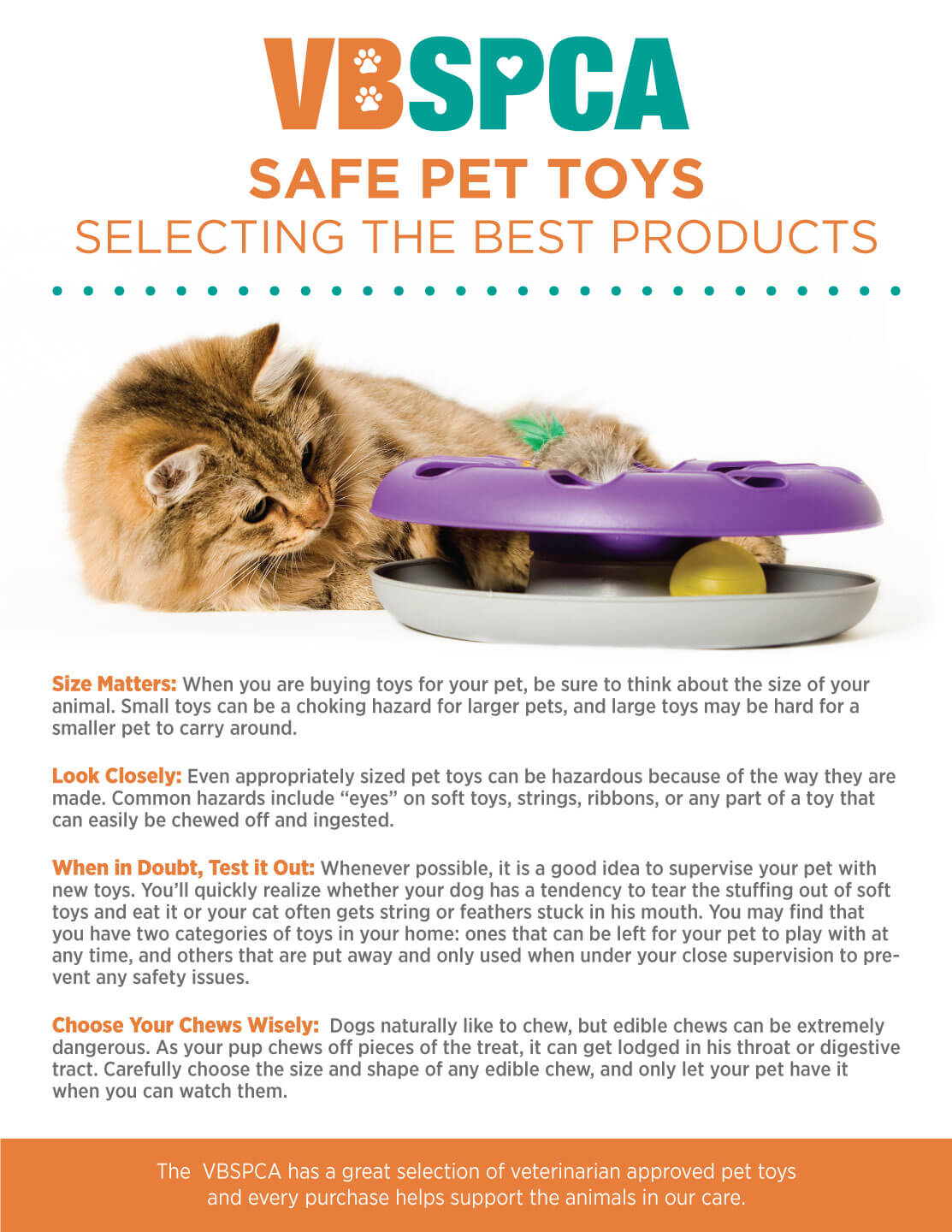



















Last Updated: June 2, 2022 by vbspcaadmin
Trish Blue | In Service to the VBSPCA for 15+ Years
For more than 15 years, Trish Blue has served on the VBSPCA Board of Directors. “I wanted to support an organization with a mission that I was passionate about,” she says.
Blue is most passionate about finding homes for shelter animals and educating the community on how to be responsible pet parents. However, she encourages everyone to get involved in the VBSPCA’s mission in any way they can. Her advice: “Find the one area [of the mission] you are most passionate about to become involved in, whether that be volunteering time in our kennels, attending our fundraising events, joining the board, or, if your time is limited, donate!”
The VBSPCA cannot work towards eliminating animal suffering without the support of dedicated community members like Blue. We truly appreciate all she does for our animals!
If you are interested in serving on the Virginia Beach SPCA Board of Directors, please email Derby.Brackett@vbspca.com for more information.